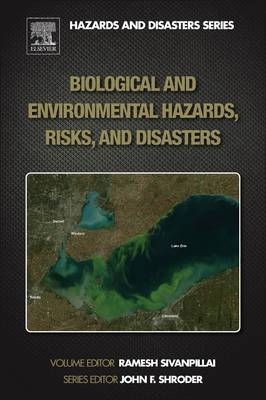
Biological and Environmental Hazards, Risks, and Disasters
Elsevier Science Publishing Co Inc (Verlag)
978-0-12-394847-2 (ISBN)
- Titel erscheint in neuer Auflage
- Artikel merken
This volume, from Elsevier’s Hazards and Disasters Series, provides an in-depth view of threats, ranging from microscopic organisms to celestial objects. Perspectives from both natural and social sciences provide an in-depth understanding of potential impacts.
Ramesh Sivanpillai is a remote sensing scientist with the University of Wyoming where he teaches remote sensing and environmental sciences courses and directs the WyomingView program. Ramesh received his B. Sc in physics (PSG College of Arts & Science, India); M. Sc in environmental studies (Cochin University of Science & Technology, India); M. Phil in environmental sciences (Bharathiar University, India); M.S in environmental sciences (University of Wisconsin – Green Bay, USA), and PhD in forestry (Texas A&M University, USA). Since 1992, he has been working with remotely sensed data for applications in forestry, rangeland, agriculture, water bodies, disaster monitoring, and land cover/land use mapping. He has worked with national and international agencies, and academic institutions in India, United States of America, Mexico, Mali, Nicaragua, Kazakhstan, Uzbekistan, Russia, Kenya, and Australia. Ramesh has published papers and book chapters in remote sensing applications in agriculture, forestry, environmental and habitat mapping, water and floods. He has served on the Board of Directors of AmericaView and is a member in the board of the ASPRS-RMR chapter. He serves as the associate editor for the Journal of Applied Remote Sensing and Frontiers of Earth Science. Ramesh has received the Project Manager training from the International Charter on Space Disasters and managed two of its activations in 2011 (flooding) and 2018 (wildfires). Ramesh was elected as the Fellow of the American Society of Photogrammetry and Remote Sensing in 2021 for his contributions to remote sensing education and applied research. Dr. John (Jack) F. Shroder received his bachelor’s degree in geology from Union College in 1961; his masters in geology from the University of Massachusetts – Amherst in 1963, and his Ph.D. in geology at the University of Utah in 1967. He has been actively pursuing research on landforms and natural resources in the high mountain environments of the Rocky Mountains, the Afghanistan Hindu Kush, and the Karakoram Himalaya of Pakistan for over a half century. His teaching specialties have been primarily geomorphology, but also physical and historical geology and several other courses at the University of Nebraska at Omaha where he was the founding professor of the Geology major. While there he was instrumental in founding the Center for Afghanistan Studies in 1972, and he was the lead geologist for the Bethsaida Archaeological Project in Israel in the 1990s. He taught geology as an NSF-, USAID, and Fulbright-sponsored professor at Kabul University in 1977-78, as well as a Fulbright award to Peshawar University in 1983-84. He has some 63 written or edited books to his credit and more than 200 professional papers, with emphases on landslides, glaciers, flooding, and mineral resources in Afghanistan. He is a Fellow of the Geological Society of America and the American Association for the Advancement of Science and has received Distinguished Career awards from both the Mountain and the Geomorphology Specialty Groups of the Association of American Geographers. In the recent decade as an Emeritus Professor, he served as a Trustee of the Geological Society of America Foundation where he set up a research scholarship, the Shroder Mass Movement award for masters and doctoral candidates. For the past two decades, he has been the Editor-in-Chief for the Developments in Earth Surface Processes book series of Elsevier Publishing, as well as the 10-volumes of the Treatise on Geomorphology, and the Hazards, Risks, and Disasters book series, both in second editions. Recently, Dr. Shroder was ranked among the top 2 percent of researchers worldwide by the October study conducted by Stanford University.
1 Introduction
2 Algal blooms Suzanne Mcgowan
3 Grasshopper Infestations Scott Schell
4 Locust swarms Jeffrey Lockwood
4.1 The Australian plague locust Chris Adriaansen
4.2 Desert locust Keith Cressman
4.3 Other locusts Ramesh Sivanpillai
5 Decline of bees and other pollinators Norman Carreck
6 Bark beetle infestation Kevin Hyde
7 Release of natural enemies James Cuda
8 Animals as hazards Rachel M. Cavin
9 Biodiversity Robert M. May
10 Environmental disease Kirsten M.M. Beyer
11 Land degradation Paolo D'Odorico
11.1 Desertification Sarah Harris
11.2 Grassland Degradation Abbey F. Wick
11.3 Rangeland Ecosystems Jay P. Angerer
12 Deforestation Richard Houghton
12.1 Deforestation SE Asia Edgar C. Turner
12.2 Nepal Ram P. Chaudhary
12.3 Deforestation in Latin America Timothy Boekhout van Solinge
13 Ecological impacts of climate change George Malanson
14 Comet and asteroid strikes René A. De Hon
| Reihe/Serie | Hazards and Disasters Series |
|---|---|
| Mitarbeit |
Herausgeber (Serie): John F. Shroder |
| Sprache | englisch |
| Maße | 152 x 229 mm |
| Gewicht | 930 g |
| Themenwelt | Naturwissenschaften ► Biologie ► Ökologie / Naturschutz |
| Naturwissenschaften ► Geowissenschaften ► Geologie | |
| ISBN-10 | 0-12-394847-9 / 0123948479 |
| ISBN-13 | 978-0-12-394847-2 / 9780123948472 |
| Zustand | Neuware |
| Haben Sie eine Frage zum Produkt? |
aus dem Bereich



